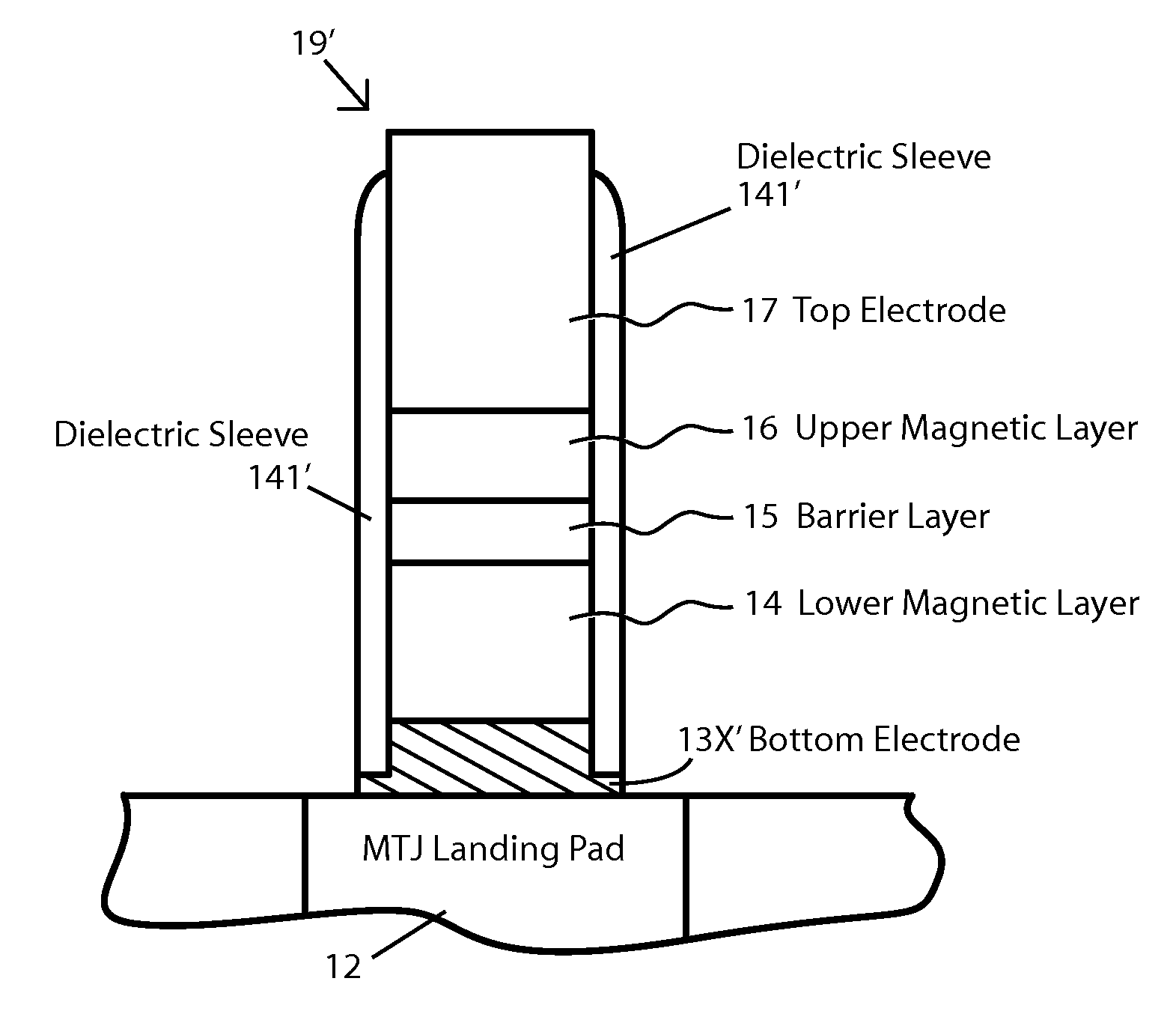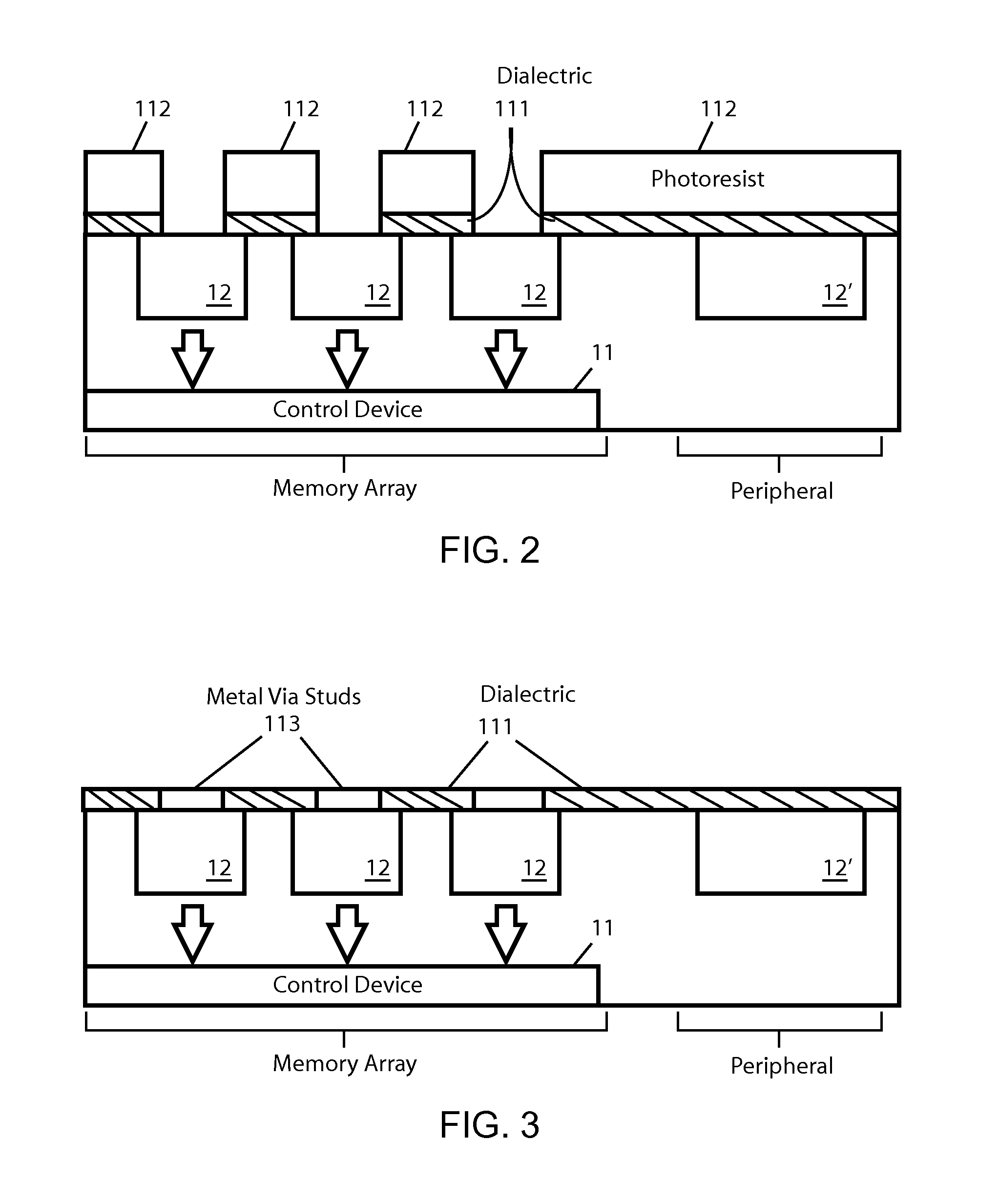Mtj memory cell with protection sleeve and method for making same
- Summary
- Abstract
- Description
- Claims
- Application Information
AI Technical Summary
Benefits of technology
Problems solved by technology
Method used
Image
Examples
first embodiment
[0025]FIG. 2-FIG. 5 illustrate cross sectional views of selected process stages for the first embodiment which minimizing exposure of landing pad metal by MTJ over-etching. As shown in FIG. 2, after the landing pad patterning process has been completed, a dielectric layer 111 is first deposited over the wafer on the exposed landing pads 12, 12′. Next using a conventional lithography process, photoresist mask 112 has been deposited and patterned as shown to allow the dielectric material to be dry etched away from the center area of the tops of the landing pads 12 while peripheral landing pad 12′ remain protected. The photoresist mask 112 covers the peripheral area metal during this etching. The gaps in the mask over the landing pads are smaller in horizontal area than the upper surface of the landing pad. This allows dielectric material to remain on the outer edges of the landing pads 12 after etching, but central vias have been formed exposing a portion of the upper surface of the l...
second embodiment
[0029]The second embodiment patterns the MTJ and bottom electrode separately. An etch-stop layer is deposited on the ILD before the landing pads are formed by the damascene process. In this embodiment the MTJ mask can optionally be patterned before or after the bottom electrode mask. In one alternative the bottom electrode mask covers metal under the bottom electrode. The embodiment where the bottom electrode is defined prior to MTJ, the etch-stop layer stops bottom electrode etching to prevent building a deep step structure at the edge of the bottom electrode. This avoids the problem of the MTJ stack deposited on sidewall of the deep step being difficult to clean away.
[0030]FIG. 6-FIG. 11 illustrate cross sectional views of selected process stages for the second embodiment which cover the landing pads 12 and peripheral pad 12′ with an additional bottom electrode mask that is separate from an MTJ mask. Etch-stop layer structures 121 for the bottom electrode etching are patterned on ...
third embodiment
[0036]FIG. 11-FIG. 14 illustrate cross sectional views of selected process stages for the third embodiment. The set of layers for the MTJ device, including a hard mask above the top electrode, is first deposited in sequence. Each of these layers including the hard mask can be standard materials. The photoresist (not shown) for the pillars is patterned by using conventional lithography and then dry etching proceeds to achieve the stage as shown in FIG. 11, where the etching process has been stopped as soon the barrier layer has been etched through or optionally at any point in the barrier layer. At this stage partially formed pillars 19B include the barrier layer and all layers above it. The layers for the lower magnetic layer 114 and the bottom electrode 113 are still continuous full films. The top layer of pillars 19B is the hard mask (not shown).
[0037]A subsequent stage is illustrated in FIG. 12 after an oxygen free dielectric material has deposited without breaking vacuum and the...
PUM
 Login to View More
Login to View More Abstract
Description
Claims
Application Information
 Login to View More
Login to View More - R&D
- Intellectual Property
- Life Sciences
- Materials
- Tech Scout
- Unparalleled Data Quality
- Higher Quality Content
- 60% Fewer Hallucinations
Browse by: Latest US Patents, China's latest patents, Technical Efficacy Thesaurus, Application Domain, Technology Topic, Popular Technical Reports.
© 2025 PatSnap. All rights reserved.Legal|Privacy policy|Modern Slavery Act Transparency Statement|Sitemap|About US| Contact US: help@patsnap.com



